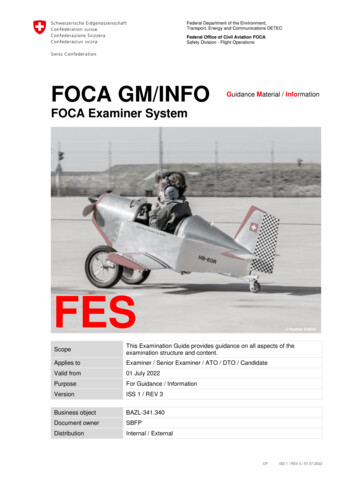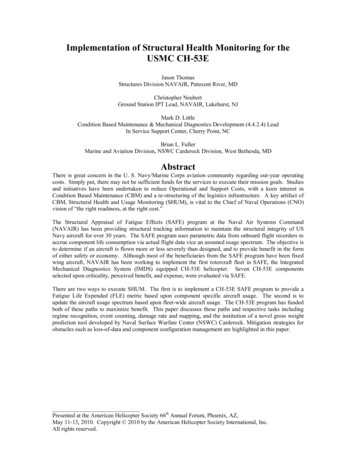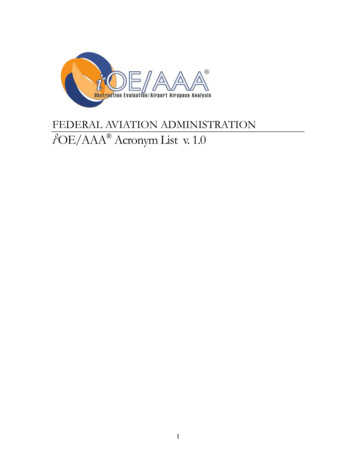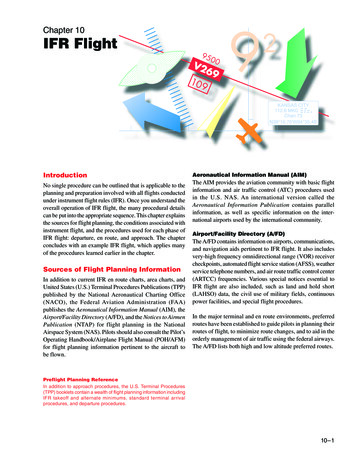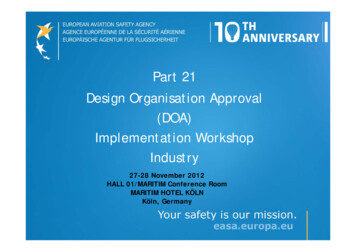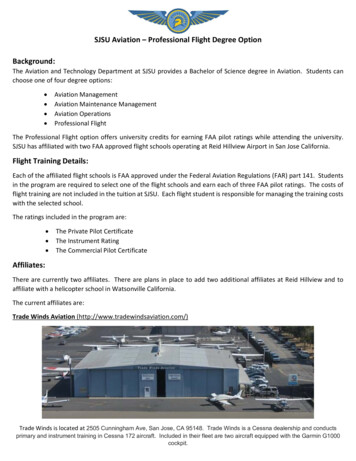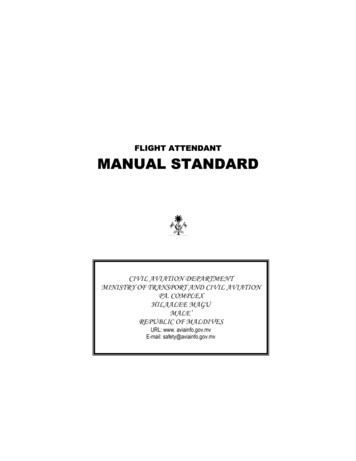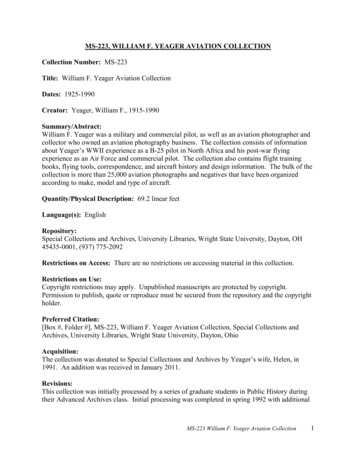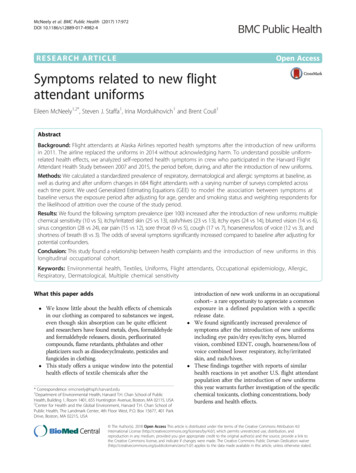
Transcription
McNeely et al. BMC Public Health (2017) 17:972DOI 10.1186/s12889-017-4982-4RESEARCH ARTICLEOpen AccessSymptoms related to new flightattendant uniformsEileen McNeely1,2*, Steven J. Staffa1, Irina Mordukhovich1 and Brent Coull1AbstractBackground: Flight attendants at Alaska Airlines reported health symptoms after the introduction of new uniformsin 2011. The airline replaced the uniforms in 2014 without acknowledging harm. To understand possible uniformrelated health effects, we analyzed self-reported health symptoms in crew who participated in the Harvard FlightAttendant Health Study between 2007 and 2015, the period before, during, and after the introduction of new uniforms.Methods: We calculated a standardized prevalence of respiratory, dermatological and allergic symptoms at baseline, aswell as during and after uniform changes in 684 flight attendants with a varying number of surveys completed acrosseach time point. We used Generalized Estimating Equations (GEE) to model the association between symptoms atbaseline versus the exposure period after adjusting for age, gender and smoking status and weighting respondents forthe likelihood of attrition over the course of the study period.Results: We found the following symptom prevalence (per 100) increased after the introduction of new uniforms: multiplechemical sensitivity (10 vs 5), itchy/irritated skin (25 vs 13), rash/hives (23 vs 13), itchy eyes (24 vs 14), blurred vision (14 vs 6),sinus congestion (28 vs 24), ear pain (15 vs 12), sore throat (9 vs 5), cough (17 vs 7), hoarseness/loss of voice (12 vs 3), andshortness of breath (8 vs 3). The odds of several symptoms significantly increased compared to baseline after adjusting forpotential confounders.Conclusion: This study found a relationship between health complaints and the introduction of new uniforms in thislongitudinal occupational cohort.Keywords: Environmental health, Textiles, Uniforms, Flight attendants, Occupational epidemiology, Allergic,Respiratory, Dermatological, Multiple chemical sensitivityWhat this paper adds We know little about the health effects of chemicalsin our clothing as compared to substances we ingest,even though skin absorption can be quite efficientand researchers have found metals, dyes, formaldehydeand formaldehyde releasers, dioxin, perfluorinatedcompounds, flame retardants, phthalates and otherplasticizers such as diisodecyclmaleate, pesticides andfungicides in clothing. This study offers a unique window into the potentialhealth effects of textile chemicals after the* Correspondence: emcneely@hsph.harvard.edu1Department of Environmental Health, Harvard T.H. Chan School of PublicHealth, Building 1, Room 1401, 655 Huntington Avenue, Boston, MA 02115, USA2Center for Health and the Global Environment, Harvard T.H. Chan School ofPublic Health, The Landmark Center, 4th Floor West, P.O. Box 15677, 401 ParkDrive, Boston, MA 02215, USAintroduction of new work uniforms in an occupationalcohort– a rare opportunity to appreciate a commonexposure in a defined population with a specificrelease date. We found significantly increased prevalence ofsymptoms after the introduction of new uniformsincluding eye pain/dry eyes/itchy eyes, blurredvision, combined EENT, cough, hoarseness/loss ofvoice combined lower respiratory, itchy/irritatedskin, and rash/hives. These findings together with reports of similarhealth reactions in yet another U.S. flight attendantpopulation after the introduction of new uniformsthis year warrants further investigation of the specificchemical toxicants, clothing concentrations, bodyburdens and health effects. The Author(s). 2018 Open Access This article is distributed under the terms of the Creative Commons Attribution 4.0International License (http://creativecommons.org/licenses/by/4.0/), which permits unrestricted use, distribution, andreproduction in any medium, provided you give appropriate credit to the original author(s) and the source, provide a link tothe Creative Commons license, and indicate if changes were made. The Creative Commons Public Domain Dedication o/1.0/) applies to the data made available in this article, unless otherwise stated.
McNeely et al. BMC Public Health (2017) 17:972BackgroundIn 2011, flight attendants at Alaska Airlines receivednew uniforms that resulted in 800 health complaints between early 2011 and February 2014, at which point theuniforms were recalled [1]. Employees had reported skinreactions, hair loss, breathing problems, thyroid dysfunction, headaches, fatigue, and chemical sensitivity in association with the rollout of the new uniform. Accordingto the employee union health and safety website for theAssociation of Flight Attendants-CWA, the airline andthe manufacturer conducted separate laboratory tests ofthe materials, specifically, testing for tributyl phosphate,but found low quantities that were not expected to causereactions [2]. The flight attendants launched a class action suit against the manufacturer in 2012 but lost thecase in 2016 because of a lack of proof of known healthconsequences at the levels of the chemicals found in theuniforms [3, 4]. In addition, the National Safety andHealth Administration (NIOSH) conducted a HealthHazard Review (HHE) and found that the uniforms wereunlikely to be related to the health complaints becauseof a lack of scientific evidence for chemical toxicity according to the quantities in the material and because theprevalence rates of dermatitis in the flight attendantswere not dissimilar to the general population [5].Gauging the health consequences of the new uniformswas complicated by limited data about reactions to textile chemicals in the general population and limited dataabout the onset and scope of reactions in the flight attendant population specifically.Further testing of uniform chemicals was ordered bythe union and performed by the Hohenstein TextileTesting Institute (Hohenstein, Germany). This laboratory found the presence of several concerning compounds, including dispersion dyes that are banned in theEurpoepan Union because of suspected carcinogenicity,and tributyl phosphate, a known irritant and potentialendocrine disrupting compound [6]. Tributyl phosphatehas been found to cause eye, skin, and respiratory irritation if inhaled, in contact with skin or eyes, or ingested[7]. Various heavy metals (i.e. lead, arsenic, cobalt, chromium, and antimony) and biocides (known to be irritants and sensitizers) used to prevent mold growthduring shipment were also detected. Despite these findings, a direct connection between exposure to thesecompounds via textiles, individually or as a mixture, andsymptom development in flight attendants or the generalpopulation is unknown.Historically, toxic and hazardous chemical compoundshave been found in clothing and furniture since the1960s [8]. This prompted the EU to create consumerproduct safety regulations, and the United States to produce voluntary guidelines for product safety [9]. Despitethis awareness, case reports of health effects fromPage 2 of 8chemicals in textiles continue to be reported, particularlyfor synthetic fabrics embedded with anti-wrinkle andstain resistant properties and dyes [10]. In the airline industry alone, TSA agents reported reactions in the eye,ear, nose, and throat as well as dermatological reactionsdue to new employee uniforms in 2009 [11]. In 2011,the Alaska Airline flight attendants began reportinghealth symptoms in relation to their new uniforms. Mostrecently, in late 2016, many American Airlines flight attendants began reporting reactions to their new uniforms sourced from the same uniform supplier as AlaskaAirlines [12–14].Little is known about the prevalence of health effectsdue to chemical exposures in textiles. In the UnitedStates, product labeling does not include chemical treatment information for fabrics [15]. Moreover, the use ofchemical compounds in fabric manufacturing is largelyunregulated, even though these chemicals include carcinogens, sensitizers, and endocrine disruptors [16].While the EU requires textile testing, certifying, labeling, and recalling for health protection, U.S. manufacturers follow voluntary guidelines for material testingand chemical reporting that result in a patchwork ofpractices. Consequently, U.S. consumers may be largelyuninformed about chemical exposures in garments andpotential health consequences [17].Today, health complaints related to textiles/clothingremain mostly anecdotal without sufficient informationor context to decipher a possible casual relationship. Forexample, we lack complete information about onset andduration of symptoms, symptom prevalence (includingaccounts of non-reporting), individual and combinedchemicals constituents in clothing, and history of exposure levels in actual use or work conditions. The objectiveof this study was to explore and quantify the associationsbetween the Alaska Airlines flight attendant healthsymptoms before, during and after the introduction ofnew uniforms.MethodsWe conducted a time series analysis of health symptomsin active Alaska Airline crew who were already part of alarger study, the Harvard Flight Attendant HealthSurvey. The study began in 2007, with two follow-up periods in 2013 and 2015. The baseline year of 2007 marksthe period before the introduction of the uniforms, 2013(up until February 1, 2014) marks the period when thenew uniforms were worn by the flight crew, and the year2015 marks the period after the uniforms were recalled.Study populationThe study sample was drawn from all flight attendantswho identified as Alaska Airline crew in 2007 and whocompleted at least one follow up survey of the Harvard
McNeely et al. BMC Public Health (2017) 17:972Flight Attendant Health Survey. Our cohort consists ofall active flight attendants. This selection included 684Alaska Airlines flight attendants in 2007, 117 flight attendants in 2013, and 249 flight attendants in 2015.There were a total of 65 flight attendants in our samplethat completed all three surveys (2007, 2013, and 2015).This subset of flight attendants showed similar results asthose found in the full study population.InstrumentsThe Harvard Flight Attendant Survey includes questionsabout job history (i.e. tenure, work hours, airline, routes,job demands) and work exposures, health symptoms inthe last week and last year, medical diagnoses, surgeries,work-related illnesses, and occupational injuries [18]. Inaddition, we collected demographic and lifestyle-relatedvariables including gender, age, ethnicity, body massindex, smoking status and history of substance use. Thehealth questions were drawn from existing populationbased surveys, such as the National Health and NutritionExamination Survey (NHANES), to allow comparisonwith the general population. We modified our questionsslightly over the years as the format changed from a hardcopy survey in 2007 to an online format in 2013 thatallowed the inclusion of more items/questions.VariablesHealth outcomesSelf-reported symptoms noted in each year were considered as health effects of interest. Every survey askedabout symptomology in two ways: “In the past week,how many days did you experience symptoms?” and “Inthe past year, did you seek care for symptoms?”. The firstquestion type was recoded as binary(4 or more days vs.3 or fewer days). The second question type was dichotomized as “yes” or “no”.We examined associations between uniform exposure and symptoms from the four main impact areaslisted below:1. EENT (Eyes, Ears, Nose, Throat): blurred vision, eyepain/dry eyes/itchy eyes, sinus congestion, ear pain,nosebleeds, sore throat, sinus pain, ear drumrupture, ear infection, runny nose, ringing ears. Notethat eye pain, dry eyes, and itchy are were groupedinto one variable.2. Lower Respiratory: shortness of breath, cough,hoarseness/voice loss, wheezing, lung infection(pneumonia) symptoms, asthma symptoms, bronchitissymptoms.3. Skin: itchy/irritated skin, rash/hives.4. Multiple Chemical Sensitivity (MCS) symptoms.Page 3 of 8First, we created a composite score for each systemarea by combining multiple symptoms by constructingbinary variables to indicate if a flight attendant reportedat least one of the symptoms in that impact category.Grouped variables were only useful when items wereasked in all three years of the survey, to allow for validcomparisons across survey years.We also evaluated models for individual or more finelygrouped symptoms specifically dry eyes, itchy eyes, eyepain, blurred vision, sinus congestion, sinus pain, earpain, ear drum rupture, ear infection, nosebleeds, runnynose, sore throat, ringing ears, combined EENT, cough,hoarseness/loss of voice, wheezing, lung infection symptoms, asthma symptoms, bronchitis symptoms, shortness of breath, combined lower respiratory, multiplechemical sensitivity symptoms, combined allergic symptoms, itchy/irritated skin, rash/hives, and combined dermatologic symptoms.ExposureThe new type of uniform introduced to Alaska Airlinesflight attendants in 2011 is the exposure of interest. The2013 survey, which includes surveys through February 1,2014, is representative of exposure to the new uniforms.Survey years 2007 and 2015 are used for comparison, with2007 as the baseline, since both survey years reflect theAlaska Airlines flight attendants using other uniforms. Theclothing materials in new and replacement uniforms canbe found in the Appendix.CovariatesCovariates in the models were age, gender, and currentand past smoking.Statistical methodsWe utilized STATA (Version 11.3, StataCorp, College Station, Texas) for descriptive statistics and data management,and we utilized SAS (Version 9.4, SAS Institute Inc., Cary,North Carolina) PROC GENMOD for statistical modeling.Inverse Probability Weighting was used to generate weightsfor each survey in the final Generalized Estimating Equations model of the odds of each symptom to account forthe probabilities of attrition in the sampling frame. Separatelogistic regression models were used to produce the fittedprobabilities for return in 2013 and 2015 to implement inverse probability weighting. The study is observational andexploratory, so we did not correct for multiple testing.ResultsThe sample included 684 Alaska Airline flight attendantswho completed a health survey in 2007 with varying survey completion rates in the follow-up years. The characteristics of the participant pool at each time period arelisted in Table 1.
McNeely et al. BMC Public Health (2017) 17:972Page 4 of 8Table 1 Characteristics of survey participants by waveSurvey Year200720132015Totaln (%)n (%)n (%)n (%)684117249105018–24 years old11 (2)0 (0)0 (0)11 (1)25–34 years old109 (15)2 (2)3 (1)114 (11)35–44 years old195 (29)11 (10)28 (11)234 (23)NAge (n 1039)45–54 years old258 (38)41 (37)95 (39)394 (38)55–64 years old105 (15)43 (39)95 (39)243 (23)65–74 years old4 (1)13 (12)24 (10)41 (4)75 years or older1 (0)0 (0)1 (0)2 (0)Female573 (84)98 (84)203 (83)874 (84)Male111 (16)18 (16)43 (17)172 (16)Gender (n 1046)Overweight (n 904)No607 (91).155 (68)772 (85)Yes59 (9).73 (32)132 (15)No662 (97)103 (99)226 (97)991 (97)Yes22 (3)1 (1)6 (3)29 (3)No504 (74)86 (83)189 (83)779 (77)Yes180 (26)18 (17)40 (17)238 (23)159 (25).3 (1)162 (19)Current Smoker (n 1020)Past Smoker (n 1017)Tenure (n 863) 6 years6–10 years130 (21).27 (11)157 (18)11–15 years47 (8).36 (15)83 (10)16–20 years102 (16).27 (12)129 (15) 20 years190 (30).142 (61)332 (38)High school graduate39 (6)6 (6)15 (7)60 (6)GED0 (0)0 (0)3 (1)3 (0)Some college, no degree279 (41)40 (38)89 (39)408 (40)Education (n 1009)Two-year college degree114 (16)17 (16)34 (15)165 (16)Four-year college degree215 (32)35 (34)74 (33)324 (33)Graduate education32 (5)6 (6)11 (5)49 (5)We calculated a standardized prevalence rate shown inthe following Figures for several symptoms among theparticipants in each of the survey years. Note that missing entries occur in years when the survey question wasnot included. Each figure represents one of the fourmain symptom impact areas; EENT (Fig. 1), LowerRespiratory (Fig. 2), Skin and MCS (Fig. 3).The prevalence of several symptoms appeared to spikein 2013, the year when the new uniforms were in use.The prevalence rate (per 100) increased for itchy eyes(24 vs 14), blurred vision (14 vs 6), sinus congestion (28vs 24), ear pain (15 vs 12), sore throat (9 vs 5), cough(17 vs 7), hoarseness/loss of voice (12 vs 3), shortnessof breath (8 vs 3), multiple chemical sensitivity symptoms (10 vs 5), itchy/irritated skin (25 vs 13), andrash/hives (23 vs 13).To assess symptoms within individuals over time andto account for selection bias due to uneven follow-upamong participants, we used Weighted GeneralizedEstimating Equations. For all analyses, we applied untrimmed inverse probability weights. A sensitivity analysis showed that using untrimmed weights lead toconservative p-values and results.Each symptom of interest was modeled separately andadjusted for sex, age, past smoking, and current smoking. We calculated odds ratios and 95% confidence intervals to test the strength of the associations. Fig. 4displays the point estimates for the odds ratio for 2013vs. baseline with 95% confidence intervals for each outcome of interest. Baseline is taken to be 2007, except forthe model for multiple chemical sensitivity symptomswhere 2015 is taken to be baseline because these symptoms were not included in the 2007 survey.Figure 4 shows that all point estimates for the odds ratios are greater than 1. Outcomes with 95% confidenceintervals excluding the null are: eye pain/dry eyes/itchyeyes (OR: 5.8; CI: 3.4, 9.9; p 0.001), blurred vision (OR:2.5; CI: 1.2, 5.0; p 0.009), combined EENT (OR: 2.0; CI:1.3, 3.0; p 0.001), cough (OR: 2.3; CI: 1.2, 4.2; p 0.011), hoarseness/loss of voice (OR: 3.7; CI: 1.7, 8.4; p 0.001), combined lower respiratory (OR: 2.4; CI: 1.4, 4.2;p 0.001), itchy/irritated skin (OR: 2.2; CI: 1.2, 4.2; p 0.012), and rash/hives (OR 1.9; CI: 1.2, 3.3; p 0.011).Non-significant outcomes include sinus congestion (OR:1.1; CI: 0.7, 1.8; p 0.562), ear pain (OR: 1.0; CI: 0.6, 1.9;p 0.961), sore throat (OR: 1.8; CI: 0.8, 4.1; p 0.163),shortness of breath (OR: 1.8; CI: 0.6, 5.3; p 0.306), andmultiple chemical sensitivity symptoms (OR: 2.2; CI: 0.9,5.1; p 0.061). Imprecise confidence intervals are associated with relatively low response rates for these questions.Overall, the new uniforms are positively associatedwith specific health symptoms in our cohort of flightcrew, with greater overall symptomology in 2013 ascompared to baseline.DiscussionThis study is the first to specify symptom prevalencerates in flight attendants after the introduction of newuniforms that generated numerous health complaints.Our investigation followed individuals over time toquantify the association between uniform exposures andsymptoms occurring before, during and after the introduction of the suspect uniforms. We found that theintroduction of the new flight attendant uniforms in
McNeely et al. BMC Public Health (2017) 17:972Page 5 of 8Fig. 1 Plot of unweighted prevalence of EENT symptomsAlaska Airlines was associated with increased EENT,lower respiratory, and skin symptoms.The study relies on general health data collected as partof an on-going cohort of flight attendants. We accessedthe cohort data retrospectively after the development ofpublicized uniform complaints. We expect, therefore, thatany participant or researcher bias related to data collection with a specific hypothesis in mind was minimized.This opportunity to access a large cohort of flight attendants with exposure to the uniforms in question alsopermitted control for potentially confounding health variables such as age and smoking. The knowledge of uniformcomplaints circulating among flight attendants in this airline at the time may have raised awareness and thereforereporting of particular symptoms, but we believe this riskis small due to the more general purpose of the survey inwhich hundreds of data points were gathered.Fig. 2 Plot of unweighted prevalence of lower respiratory symptomsBecause of our retrospective design, we were unable toinvestigate other flight attendant health complaints potentially related to the new uniforms, such as symptomsof hair loss or thyroid dysfunction. Other studies havereported hair loss in relation to metals found in the textile dyes and thyroid dysfunction related to endocrinedisruptors such as phthalates, also found in the uniforms[19–21]. Unfortunately, data about these conditions werenot collected.The survey data used for this analysis have several inherent limitations. First, all questions are answered byself-report and therefore our measures are subjective;there are no physician evaluations, medical records, ortests used to obtain health related information, whichhas likely led to misclassification of outcomes. The survey waves are also unevenly spaced, allowing for accumulated events or insidious problems unrelated to the
McNeely et al. BMC Public Health (2017) 17:972Page 6 of 8Fig. 3 Plot of unweighted prevalence of skin and MCS symptomsexposure to be counted for the year 2013. However, thesymptom questions in this survey are constrained by aseven-day window of experience and a visit to a careprovider within the last year, thus, minimizing the problem of over-counting, and our analyses are adjusted forage, thus reducing the possibility of symptoms arisingsolely due to increasing age. Finally, our study was exploratory in nature, and we therefore did not correct formultiple testing.Importantly, the exposure in this study is measured byproxy—according to time, and not according to specificchemical constituents. Although we have access to anumber of chemical analyses from the airline, the manufacturer and laboratories commissioned by the union,the chemical compounds that can potentially be foundin the materials are dependent on the different chemicalpanels included, the methods of analysis, and thematerials tested. Importantly, the chemical compoundconcentrations varied by garment and material tested,and overall, these results tell us very little about the actual body burdens for any single chemical or mixture ofcontaminants or their possible health effects.While harmful chemicals in clothing and furniturehave lead to some product bans, labeling, and consumerprotection rules (i.e. flame retardants, pthalates, formaldehyde) [22] chemicals in use are not routinely tested.Therefore, we generally know about harmful chemicalexposures “after the fact” or once problems are revealed.It is also worth noting that similar uniform complaintshave been raised among flight attendants of different airlines, most recently by American Airlines flight attendants in late 2016 [14].In addition, even when testing is required in places likethe European Union, testing given extreme environmentsFig. 4 Plot of 2013 vs. baseline odds ratios in separate models. Odds ratios and 95% confidence intervals for the new uniform exposure year 2013vs. baseline are shown for each outcome. Baseline is the exposure year 2007 for all outcomes, except multiple chemical sensitivity symptoms anditchy/irritated skin, for which 2015 is treated at baseline. Odds ratio estimates are denoted by “x” and 95% confidence limits are denoted by circles
McNeely et al. BMC Public Health (2017) 17:972Page 7 of 8or novel uses, or in the presence of other compounds, isnot generally carried out. However, studies of aircraftcabin environments have found harmful compounds released from clothing and upholstery because of interactions with ozone in flight [23, 24]. Flight attendants areexposed to an unusual occupational environment, whichincludes various cabin air contaminants, Circadian rhythmdisruption, high occupational noise, as well as changes inpressure, oxygenation, and humidity [25], and it is unclearhow all of these factors come together to affect potentialreactions to chemical compounds in clothing.Our study findings are important not only for flight attendants. An occupational cohort sometimes makes visible the magnitude of harmful exposures by the sheervolume of complaints in a defined population that maybe otherwise invisible or interpreted as individual sensitivity. Our findings raise the question of whether flightattendant symptoms experienced in relation to theintroduction of new uniforms may suggest a potentialproblem for the population at large in regard to chemicals in our clothes.Unfortunately, we know little about chemicals in ourclothing as compared to substances we ingest, eventhough skin absorption can be quite efficient, as weknow from new drug delivery mechanisms. Further, inthe case of many chemicals, threshold levels for healtheffects are based on a few animal studies [26], as opposed to large randomized clinical trials. In addition,relatively few chemicals of concern in clothing have beentested in laboratories. Besides metals and dyes, important clothing contaminants are formaldehyde and formaldehyde releasers, dioxin, perfluorinated compounds,flame retardants, phthalates and other plasticizers suchas diisodecyclmaleate, and pesticides used in shipment[27–30]. These and other chemicals have been associated with serious health consequences in laboratory andepidemiologic studies [31, 32].In summary, additional analyses of the chemical compounds in flight attendant uniforms that are needed include modeling exposures based on concentrations,chemical binding, dispersions with sweat and friction,skin absorption and chemical reactions and breakdowndue to concomitant exposures such as UV radiation andozone chemistry aboard the aircraft. The exposure ofchemical contaminants in textiles need much furtherstudy particularly in regard to body burdens and safeconcentrations under conditions of use.We found that the introduction of new flight attendantuniforms was associated with quantifiable health effects.More specifically, we found the new uniform introduction to be related to skin rashes and itchiness, as well asrespiratory and allergic symptoms. Our study is the firstto examine the relationship between uniforms containing harmful chemical compounds and health outcomes, and our flight attendant cohort allowed usthe opportunity to do so in a rigorous way. Theseresults raise the seriousness of the flight attendantcomplaints about potential harms and the need forfurther investigation.ConclusionsThis study was not designed to identify specific harmfulcompounds or to estimate dose–response thresholds.Rather, the purpose of this study was to provide information regarding the likelihood that textile exposuresmay be associated with health effects among flight crew.FundingThis research was funded in part by grants from the US Federal AviationAdministration (FAA) Office of Aerospace Medicine through the National AirTransportation Center of Excellence for Airliner Cabin Environment Research(ACER)/Research in the Intermodal Transport Environment (RITE), CooperativeAgreements 10-C-RITE-HU, 07-C-RITE-HU and 04-C-ACE-HU. the Marilyn HoffmanProgram on Chemicals and Health at the Harvard T.H. Chan School of PublicHealth, and the Flight Attendant Medical Institute (FAMRI).AppendixTable 2 Clothing materials in new and replacement uniforms*GarmentNew Uniforms2011–14ReplacementUniforms 2014–17Skirt50% wool, 48% polyester,2% spandex (lining 100%polyester) - assembled inIndonesia51% polyester, 42% wool,7% elastane (lining 100%polyester) - assembledin Sri LankaBlazer53% polyester, 43% wool,4% elastane (lining 100%polyester) - assembledin China52% polyester, 42% wool,6% spandex (lining 100%polyester) - assembled inSri LankaShirts60% cotton, 40% polyester assembled in Indonesia55% cotton, 45% polyester assembled in IndonesiaCardigan/Sweater55% acrylic, 23% wool,22% nylon - location ofassembly unknown(a wool-free acrylic/nylonalternative was also available)53% polyester, 43% wool,4% elastane (lining 100%polyester) - assembledin China55% cotton, 45% polyester assembled in IndonesiaPants53% polyester, 43% wool,4% elastane (lining 100%polyester) - assembledin China52% polyester, 42% wool,6% spandex (lining 100%polyester) - assembled inSri Lanka52% polyester, 42% wool,6% spandex (lining 100%polyester) - assembled inSri Lanka*Material information taken from flight attendant clothing labelsAcknowledgementsThe researchers wish to thank all of the flight attendants who participated inthe Harvard Flight Attendant Health Survey.
McNeely et al. BMC Public Health (2017) 17:972Availability of data and materialsThe dataset supporting conclusions of this article is available by contactingDr. Eileen McNeely.DisclaimersThe authors are solely responsible for the research and the findings do notrepresent the opinions or endorsement of any of the funders.Authors’ contributionsEM designed and conducted the flight attendant health survey. SS, BC andEM designed and conducted the study’s statistical analyses, and IM providedsome additional feedback on this aspect of the study. SS, EM, and IM draftedthe manuscript, and all authors contributed to its contents. All authors readand approved the final manuscript.Ethics approval and consent to participateThis study was approved by the Harvard T.H. Chan School of Public Healthinstitutional review board, and all participants provided their writteninformed consent.Consent for publicationNot applicable.Competing interestsThe authors declare that they have no competing interests.Publisher’s NoteSpringer Nature remains neutral with regard to jurisdictional claims inpublished maps and institutional affiliations.Received: 19 July 2017 Accepted: 6 December 2017References1. Air Safety, Health and Security Department. Air Safety, Health and securitydepartment. 2017. http://ashsd.afacwa.org/?zone %2Funionactive%2Fviewarticle.cfm&HomeID 160011. Accessed 13 Mar 2017.2. AFA-CWA Air Safety, Health, & Security De
Flight Attendant Health Survey. Our cohort consists of all active flight attendants. This selection included 684 Alaska Airlines flight attendants in 2007, 117 flight at-tendants in 2013, and 249 flight attendants in 2015. There were a total of 65 flight attendants in our sample that completed all three surveys (2007, 2013, and 2015).
